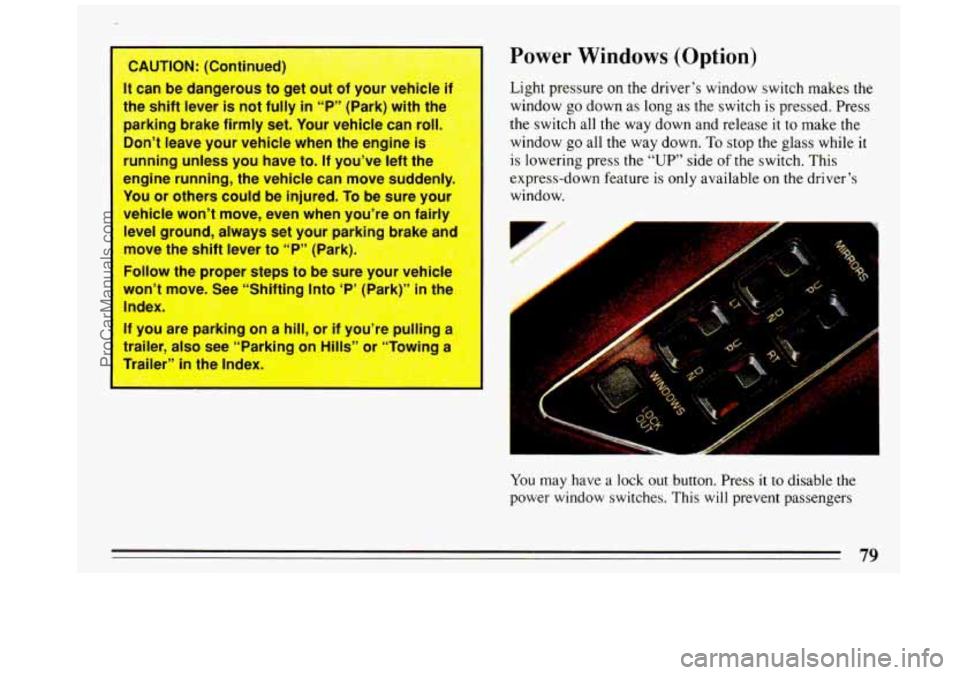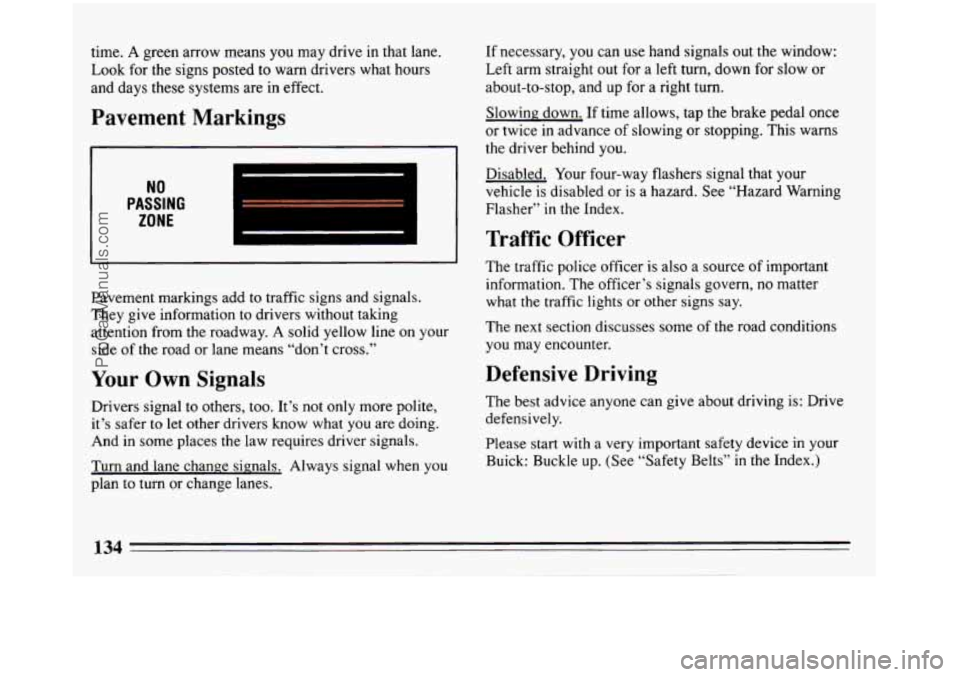Page 14 of 308
Vehicle Symbols
These are some of the symbols you will find on your vehicle.
For example,
these symbols
are used on an
original battery:
POSSIBLE A
CAUTION
INJURY
PROTECT EYES BY
SHIELDING
CAUSTIC
BURNS AVOID
SPARKS
OR
FLAMES
SPARK
OR ,\I/,
COULD FLAME
EXPLODE BATTERY
These symbols
are important
for you and
your passengers
whenever your
vehicle
is
driven:
DOOR LOCK
UNLOCK
e
e
BELTS 4
POWER
WINDOW
These symbols
have
to do with
your lights:
SIGNALS e @
TURN
HIGH BEAM
OR = =o
FOG LAMPS $0
These symbols
are on some
of
your controls:
WINDSHIELD ' ' ' 0- 0-
WASHER
WINDSHIELD WASHER
WINDOW
DEFOGGER
VENTILATING FAN
HEADLAMP
-
WIPER
WASHER
Q
These symbols
are
used on
warning and
indicator lights:
COOLANT F-
TEMP --
ENGINE
CHARGING
I-1
BATTERY SYSTEM
BRAKE
(0)
RADIATOR 0
COOLANT
FUEL
ENGINE OIL w,
PRESSURE
TEMP
OIL &b
ANTILOCK (a)
BRAKE
Here are some
other symbols
you may see:
FUSE
RADIO
VOLUME
CONDITIONING
AIR 43
HATCHBACK TRUNK
RELEASE
t LIGHTER
HORN
SPEAKER
12
ProCarManuals.com
Page 76 of 308
Pump-to-Set Parking Brake
The parking brake uses the brakes on the rear wheels.
To set the parking brake:
Hold the regular brake pedal down with your right foot.
Pump your parking brake pedal several times with your
left foot until the pedal feels firm. If the ignition is on,
the brake system warning light will come on.
Over time, more pumps may be needed to set the
parking brake firmly.
If it ever takes more than two full
pumps, have the brake system adjusted by your dealer.
To release the parking brake:
Hold the regular brake pedal down. Pull the brake
release lever.
.
NOTIC% I
Driving with the parking brake on can cause your
rear brakes to overheat. You may have to replace
your vehicle. them, and
you could also damage
74
ProCarManuals.com
Page 81 of 308

f
-
CAUTION: (Continued)
It can be dangerous to get out of your vehicle if
the shift lever
is not fully in “P” (Park) with the
parking brake firmly set. Your vehicle can roll.
Don’t leave your vehicle when the engine is
running unless you have to. If you’ve left the
engine
running, the vehicle can move suddenly.
You or others could be injured. To be sure your
vehicle won’t move, even when you’re
on fairly
level ground, always set your parking brake and
-we the shift lever to “P” (Park)
Follow the proper steps to be sure your vehicle
won’t move. See “Shifting Into ‘P’ (Park)”
in the
Index,
If you are parking on a hill, or if you’re pulling a
iler, also see “Parking on Hills” or “Towing a
ailer”
in the Index.
Power Windows (Option)
Light pressure on the driver’s window switch makes the
window go down as long as the switch is pressed. Press
the switch all the way down and release
it to make the
window go all the way down. To stop the glass while
it
is lowering press the “UP” side of the switch. This
express-down feature is only available
on the driver’s
window.
You may nave a lock out button. Press it to disable the
power window switches. This will prevent passengers
79
-
ProCarManuals.com
Page 93 of 308
To Get Out of Cruise Control To Erase Speed Memory
When you turn off the Cruise Control or the ignition, or
shift into “P” (Park)
or “N” (Neutral) your Cruise
Control set speed memory
is erased.
Lights
The light controls are on the instrument panel.
It controls these light systems:
There are two
ways to turn
off the Cruise Control:
1. Step lightly on the brake
pedal
; OR
Headlights
Taillights
Parking Lights License Lights
Sidemarker Lights
Instrument Panel
Lights
Interior Courtesy
Lights 0
;o
:o
io 2. Move the Cruise switch
to “OFF.” 10 I (The “CRUISE” light
will go out.)
io
i
91
ProCarManuals.com
Page 94 of 308

Headlight “On” Warning
If the light switch is left on you’ll hear a warning tone
when you turn the ignition
off and open the driver’s
door.
Fog Eights (GS Only Option)
If you have the fog light
feature, the control is on the
instrument. The parking
lights must be on, for the
fog lights to work. The fog
lights will turn off
when
you switch to high beam
headlights. When you
switch back to
low beam
headlights they
will turn
back on.
Daytime Running Lights (Canada Only)
The Canadian Federal Government has decided that
“Daytime Running Lights”
(DRL) are a useful feature,
in that DRL can make your vehicle more visible to
pedestrians and other drivers during daylight hours.
DRL are required on new vehicles sold
in Canada.
Your DRL work
with a light sensor on top of the
instrument panel. Don’t cover
it up.
The low beam headlights will come on at reduced
brightness
in daylight when:
0 The ignition is on
The headlight switch is off, and
The parking brake is released.
At dusk, the exterior lights will come on automatically
and the low beams will change to.full brightness.
At
dawn, the exterior lights will go out and the low beams
will change to the reduced brightness of DRL (if the
headlight switch
is off>. Of course, you may still turn on
the headlights any time you need to. To idle your vehicle
with the DRL off. set the parking brake while the
ignition
is in the “Off“ or “l,ock” position. Then start
the vehicle. The DRL
will stay off until you release the
parking brake.
92
ProCarManuals.com
Page 104 of 308

Brake System Warning Light
(a)(!)
BRAKE
Your Buick’s hydraulic
brake system is divided into
two parts. If one part isn’t
working, the other part can
still work and stop you. For
good braking, though, you
need both parts working well.
If the warning light goes on, there could be a brake
problem. Have your brake system inspected right away.
This light should come on as you start the vehicle.
If it
doesn’t come on then, have it fixed
so it will be ready to
warn you if there’s a problem. This
light will also come on when you set your parking
brake, and will stay on if your parking brake doesn’t
release fully. If it stays
on after your parking brake is
fully released, it means you have a brake problem. If the
light comes on while driving, pull off the road and stop
carefully. You may notice that the pedal is harder
to
push. Or, the pedal may go closer to the floor. It may
take longer to stop.
If the light is still on, have the
vehicle towed for service. (See “Towing Your Vehicle”
in the Index.)
A CAUTION:
Your brake system may not be working properly
if the brake warning light is on. Driving with the
brake warning light on can lead to an accident.
If
the light is still on after you’ve pulled off the road
and stopped carefully, have the vehicle towed fo
service.
aw,Tp 1 e- c -
102
ProCarManuals.com
Page 105 of 308

Anti-Lock Brake System Warning Light
(Option) anti-lock brakes. If the regular brake system warning
light is also on, see “Brake System Warning Light”
earlier
in this part.
With anti-lock, this light will go on unless you start your
engine and it will stay
on for three seconds. If the light
doesn’t come on, have it fixed
so it will be ready to
warn you
if there is a problem.
If the light stays on or comes on when you’re driving,
stop
as soon as possible and turn the key off. Then start
the engine to reset the system. If the light still stays on,
or comes
on again while you’re driving, your Buick
needs service. Unless the regular brake system warning
light is also
on, you will still have brakes, but not If
the anti-lock brake system warning light ever flashes,
your anti-lock brake system is still working but needs
.service as soon as possible.
Engine Coolant Temperature Gage
TEMP
This gage shows the engine
coolant temperature. If the
gage pointer moves into the
red area, your engine is too
hot
!
It means that your engine coolant has overheated. If you
have been operating your vehicle under normal driving
conditions, you should pull
off the road, stop your
vehicle and turn off the engine as soon as possible.
103
ProCarManuals.com
Page 136 of 308

time. A green arrow means you may drive in that lane.
Look for the signs posted to warn drivers what hours
and days these systems are in
effect.
Pavement Markings
NO
PASSING
ZONE
Pavement markings add to traffic signs and signals.
They give information to drivers without taking
attention from the roadway.
A solid yellow line on your
side of the road or lane means “don’t cross.”
Your Own Signals
Drivers signal to others, too. It’s not only more polite,
it’s safer
to let other drivers know what you are doing.
And in some places the law requires driver signals.
Turn and lane change signals. Always signal when
you
plan to turn or change lanes. If
necessary,
you can use hand signals out the window:
Left arm straight out for a left turn, down for slow or
about-to-stop, and up for
a right turn.
Slowing down. If time allows, tap the brake pedal once
or twice in advance of slowing or stopping. This warns
the driver behind you.
Disabled. Your four-way flashers signal that your
vehicle is disabled or
is a hazard. See “Hazard Warning
Flasher”
in the Index.
Traffic Officer
The traffic police officer is also a source of important
information. The officer’s signals govern,
no matter
what
the traffic lights or other signs say.
The next section discusses some of the road conditions
you may encounter.
Defensive Driving
The best advice anyone can give about driving is: Drive
defensively.
Please start with a very important safety device in your
Buick: Buckle up. (See “Safety Belts” in
the Index.)
134
-
ProCarManuals.com